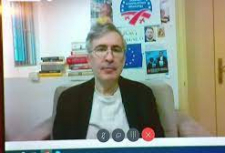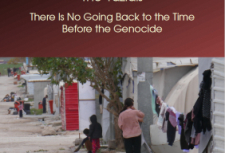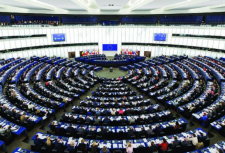Yazidism between Scholarly Literature and Actual Practice: From ‘Heterodox’ Islam and ‘Syncretism’ to the Formation of a Transnational Yazidi ‘Orthodoxy’

Robert Langer - University of Heidelberg
In this paper I present some thoughts on Yazidism’s role in the discussion on ‘orthodoxy’ and ‘heterodoxy’ in Near Eastern religious history and ethnography, and also on recent developments in transnational Yazidism. These thoughts are the result of discussions during the course of our Heidelberg research project, where we focus mainly on the Turkish and Kurdish Alevis, but also work comparatively in the field of Kurdish Yazidism, mainly with my colleague Janina Karolewski, but also with other colleagues on different occasions.2 In our research, we apply the concept of ‘ritual transfer’ in order to document and analyses transformation processes within the groups in question during the early history of their urbanization and migration.3 To that end, I carried out fieldwork both with the Yazidi community in the German diaspora and with the Yazidis in the South- Caucasian Republic of Armenia. This paper was originally presented at the Annual Meeting of the American Academy of Religion in Montre´al (Canada) in November 2009, as part of a
panel discussion on ‘Conceptualizing differences in the study of Islam: theoretical and methodological challenges’, organized by Markus Dressler. The aim was to discuss the application of the terms ‘orthodoxy’ and ‘heterodoxy’ in Islamic contexts. During the discussion it was suggested that orthodoxy can or should be understood as the dominant resource of those in power, who use it to regulate authorized, legitimate versus unauthorized, illegitimate activities. It also became clear that orthodoxy could only be understood when considered in conjunction with its counterpart heterodoxy. From this perspective, orthodoxy should not be essentialised and is not defined or agreed by consensus but more by its difference to heterodoxy, which in turn is defined by the dominant ‘orthodox’ point of view.
We can therefore suggest that orthodoxy is relative; something is orthodox or heterodox depending on one’s perspective and standpoint. Therefore, of course, there can also be orthodoxy within heterodoxy, as in ‘heterodox’ groups such as the Yazidis. Orthodoxy implies agents, as Jens Kreinath observed in the context of Turkey’s headscarf conflicts.4 In my paper, I will try to develop some further thoughts on these concepts in connection with research on the Yazidi tradition and community.
Yazidis are a mainly Kurdish-speaking group who share a distinctive religious tradition. The Kurdish name is pronounced Ezdıˆ or Ezidı different etymologies exist for this ethnonym, but there is some evidence that it stems from the Umayyad caliph Yazı¯d ibn Mu‘a¯wiya, as the ‘reformer’ of Yazidism. The twelfth century Sunni Sufi Sheikh ‘Adı¯ ibn Musa¯fir was a descendant of the Umayyad family.6 The Yazidis share several features with other marginalised, ‘heterodox’ Muslim communities, such as the Turkish and Kurdish Alevis or the Iranian Gorani- Kurdish Ahl-eHaqq, the Arab Nusayrı¯s and Druze, and other groups claimed to be ‘extremist (Shiites)’, first by Muslim heresiographers and later by western and modern oriental scholars. Philip Kreyenbroek has convincingly developed the hypothesis that this concept of ghuluww (exaggeration) was invented by Muslim heresiographers, especially orthodox Shiite ones, in order to subsume many different groups that did not conform to standard Islam. This was then partly accepted by the groups themselves, in order to placate the Muslim majority surrounding them. As Kreyenbroek writes: ‘The concept of an extremist Shı¯‘a, understood as a theoretical construct devised by an Islamic establishment in order to classify a number of heretical fringe movements – and accepted by these as part of their identity – can therefore help us understand how some of the beliefs of these groups came to be legitimized as Islamic.
One example of the features shared by these groups is the importance of a tribal kinship system within the organization of religious leaders and their connection to the laity: a ‘priestly caste’, or ‘holy lineages’, or clans of ‘holy’ origin are tied by hereditary links to lay families.
This system also involves a hierarchy and interconnection within the holy clans and different forms of fictive kinship between individuals within the same caste. Members of the religious leaders’ caste are trained in the oral texts in order to continue the tradition; this – as Kreyenbroek argues – does not result in a standardized, dogmatic canon, which is only possible within a written tradition.
The importance of kinship and tribalism implies that none of these groups practises proselytism, and there is no tradition of converting outsiders into the group; i.e. to be a full member of the group one must be born into it via both parents. Marrying outside the group traditionally resulted in loss of membership. Another feature which is common to these groups is their lack of scripture, as mentioned above, especially of a single ‘holy book’ (although there are a few written sources and texts used by clergy). The Qur’an is not generally rejected, but is not studied and used as it is in learned urban Islamic contexts; if members of ‘heterodox’ groups have to refer to the Qur’an, it is emphasized that there is a relevant hidden, inner (ba¯ tin) meaning, as opposed to the ‘outer’ ( z a¯hir) meaning of classical Islamic learning and mainstream Shariah-Islam.9 Consequently, there is no emphasis on orthodox Islamic forms of worship.
Tags: #yazidisinfo #ezidi #yazidi
Yazidism between Scholarly Literature and Actual Practice: From ‘Heterodox’ Islam and ‘Syncretism’ to the Formation of a Transnational Yazidi ‘Orthodoxy’

Robert Langer - University of Heidelberg
In this paper I present some thoughts on Yazidism’s role in the discussion on ‘orthodoxy’ and ‘heterodoxy’ in Near Eastern religious history and ethnography, and also on recent developments in transnational Yazidism. These thoughts are the result of discussions during the course of our Heidelberg research project, where we focus mainly on the Turkish and Kurdish Alevis, but also work comparatively in the field of Kurdish Yazidism, mainly with my colleague Janina Karolewski, but also with other colleagues on different occasions.2 In our research, we apply the concept of ‘ritual transfer’ in order to document and analyses transformation processes within the groups in question during the early history of their urbanization and migration.3 To that end, I carried out fieldwork both with the Yazidi community in the German diaspora and with the Yazidis in the South- Caucasian Republic of Armenia. This paper was originally presented at the Annual Meeting of the American Academy of Religion in Montre´al (Canada) in November 2009, as part of a
panel discussion on ‘Conceptualizing differences in the study of Islam: theoretical and methodological challenges’, organized by Markus Dressler. The aim was to discuss the application of the terms ‘orthodoxy’ and ‘heterodoxy’ in Islamic contexts. During the discussion it was suggested that orthodoxy can or should be understood as the dominant resource of those in power, who use it to regulate authorized, legitimate versus unauthorized, illegitimate activities. It also became clear that orthodoxy could only be understood when considered in conjunction with its counterpart heterodoxy. From this perspective, orthodoxy should not be essentialised and is not defined or agreed by consensus but more by its difference to heterodoxy, which in turn is defined by the dominant ‘orthodox’ point of view.
We can therefore suggest that orthodoxy is relative; something is orthodox or heterodox depending on one’s perspective and standpoint. Therefore, of course, there can also be orthodoxy within heterodoxy, as in ‘heterodox’ groups such as the Yazidis. Orthodoxy implies agents, as Jens Kreinath observed in the context of Turkey’s headscarf conflicts.4 In my paper, I will try to develop some further thoughts on these concepts in connection with research on the Yazidi tradition and community.
Yazidis are a mainly Kurdish-speaking group who share a distinctive religious tradition. The Kurdish name is pronounced Ezdıˆ or Ezidı different etymologies exist for this ethnonym, but there is some evidence that it stems from the Umayyad caliph Yazı¯d ibn Mu‘a¯wiya, as the ‘reformer’ of Yazidism. The twelfth century Sunni Sufi Sheikh ‘Adı¯ ibn Musa¯fir was a descendant of the Umayyad family.6 The Yazidis share several features with other marginalised, ‘heterodox’ Muslim communities, such as the Turkish and Kurdish Alevis or the Iranian Gorani- Kurdish Ahl-eHaqq, the Arab Nusayrı¯s and Druze, and other groups claimed to be ‘extremist (Shiites)’, first by Muslim heresiographers and later by western and modern oriental scholars. Philip Kreyenbroek has convincingly developed the hypothesis that this concept of ghuluww (exaggeration) was invented by Muslim heresiographers, especially orthodox Shiite ones, in order to subsume many different groups that did not conform to standard Islam. This was then partly accepted by the groups themselves, in order to placate the Muslim majority surrounding them. As Kreyenbroek writes: ‘The concept of an extremist Shı¯‘a, understood as a theoretical construct devised by an Islamic establishment in order to classify a number of heretical fringe movements – and accepted by these as part of their identity – can therefore help us understand how some of the beliefs of these groups came to be legitimized as Islamic.
One example of the features shared by these groups is the importance of a tribal kinship system within the organization of religious leaders and their connection to the laity: a ‘priestly caste’, or ‘holy lineages’, or clans of ‘holy’ origin are tied by hereditary links to lay families.
This system also involves a hierarchy and interconnection within the holy clans and different forms of fictive kinship between individuals within the same caste. Members of the religious leaders’ caste are trained in the oral texts in order to continue the tradition; this – as Kreyenbroek argues – does not result in a standardized, dogmatic canon, which is only possible within a written tradition.
The importance of kinship and tribalism implies that none of these groups practises proselytism, and there is no tradition of converting outsiders into the group; i.e. to be a full member of the group one must be born into it via both parents. Marrying outside the group traditionally resulted in loss of membership. Another feature which is common to these groups is their lack of scripture, as mentioned above, especially of a single ‘holy book’ (although there are a few written sources and texts used by clergy). The Qur’an is not generally rejected, but is not studied and used as it is in learned urban Islamic contexts; if members of ‘heterodox’ groups have to refer to the Qur’an, it is emphasized that there is a relevant hidden, inner (ba¯ tin) meaning, as opposed to the ‘outer’ ( z a¯hir) meaning of classical Islamic learning and mainstream Shariah-Islam.9 Consequently, there is no emphasis on orthodox Islamic forms of worship.
Tags: #yazidisinfo #ezidi #yazidi

























